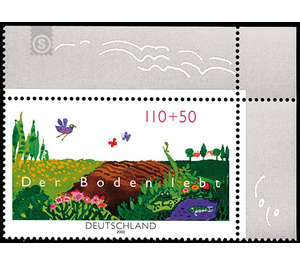For environmental protection: The soil is alive - Germany / Federal Republic of Germany 2000 - 110 Pfennig
Theme: Animals
| Country | Germany / Federal Republic of Germany |
| Issue Date | 2000 |
| Face Value | 110.00 |
| Perforation | K 13 3/4: 14 |
| Stamp Type | Postage stamp |
| Item Type | Stamp |
| Chronological Issue Number | 1989 |
| Chronological Chapter | GER-BRD |
| SID | 121819 |
| In 21 Wishlists | |
The soil consists of minerals of different types and sizes as well as various organic substances. Created over the centuries, under the influence of a particular climate, a specific vegetation and other soil-forming processes. Decisive in this are the soil organisms through their versatile conversion, construction and dismantling activities. At the same time, the chemical and physical soil properties determine the type and number of soil-dwelling organisms. The soil forms an important habitat with its water and nutrient cycles, its filter and buffer properties and its cavities. As diverse as its use are the burdens of the soil. The surface of the soil is re-isolated daily by overbuilding and sealing. In addition, wind and water erosion continuously erodes soil in quantities that can exceed 100 times the annual rate of new soil formation. In 1972, the Council of Europe's European Soil Charter explicitly stated: "Soil is one of the most precious assets of humanity. It allows plants, animals and humans to live on the surface of the earth. "With the adoption of the law for the protection of the soil in 1998, the habitat function of the soil was also subject to a precautionary federal protection. At the international level, the sustainable protection of soils is also becoming increasingly important.


